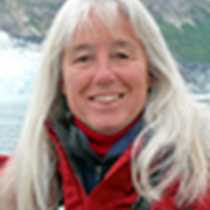Glacier Bay National Park
Early this morning the National Geographic Sea Bird entered Glacier Bay National Park and briefly docked in Bartlett Cove. Ranger/Naturalist Kevin Richards embarked to join us for the day in order to relate the dramatic story of the bay and the park – their history, culture, biology and geology.
The Fairweather Mountains have been visible to us for the last two days. These are the lofty peaks (Mount Fairweather – 15,320 ft.) that catch moisture from the Pacific Ocean and whirl it into snow, perpetuating the glaciers that have alternately extended into and receded from their surroundings. At the present time glacial recession has opened up a 65-mile waterway that enables vessels to visit and enjoy the scenery… and enjoy it we did. Today we basked in warmth and sunshine, wondering about the future of Glacier Bay if this unusual weather were to continue.
Our ship slid slowly past South Marble Island bird rookery and Steller sea lion haul-out. The noisy sea lions were entertaining but it was the tufted puffins that stole the show. We found them sitting on the water, standing by their burrows and wheeling to and fro with rapid wing beats to keep their heavy bodies aloft. Other summer nesters on the small island include black-legged kittiwakes, common murres and glaucous-winged gulls. Pelagic cormorants in shiny breeding plumage stood on the rocks.
One of the day’s objectives was to search for, and hopefully find, wildlife. We were lucky and thrilled to be rewarded with a number of excellent sightings, including a mother moose with two calves browsing on a hillside of small trees. It was a bit challenging to keep track of them as they moved amongst the shrubs, but with the help of a scope and our skills with binoculars most people had brief but good looks at the animals before they wandered over the top of the knoll. Moose are relative newcomers to Southeast Alaska and can be difficult to find, so we were glad to get a glimpse of these animals. Just moments later, entering Tidal Inlet, we watched a golden-colored brown bear foraging in the intertidal zone.
On the rocky precipices of Gloomy Knob, nanny mountain goats were followed by their young kids, relatively safe from less sure-footed predators. A description of an animal seen by a guest made us realize that a wolverine was wandering around on the rocks. Unfortunately the rarely-seen creature was not relocated, but it still created a lot of excitement among us.
At last we reached the head of Tarr Inlet, a dead end at the termini of the Grand Pacific and Margerie Glaciers. The gently sloping Grand Pacific is covered in debris and rubble and barely reaches tidewater. Margerie’s steep, gleaming face is quite active and we witnessed several calvings during the time we admired its features. Recently fallen ice floated as icebergs in front of the glacier. Only bare rock and gravel and low vegetation were present beside the ice.
Now it was time to backtrack, retracing our wake down toward the mouth of the bay. Late in the afternoon we entered Geikie Inlet, observing eagles’ nests and some adult eagles on the way in. Turning into Shag Cove, another moose was discovered standing on the beach! On the other shore a black bear ambled along the forest edge.
Finally we were back at Bartlett Cove. We said goodbye to Ranger Kevin and after dinner had a chance to stroll ashore before the National Geographic Sea Bird departed Glacier Bay National Park and continued toward tomorrow’s destinations and adventures.




